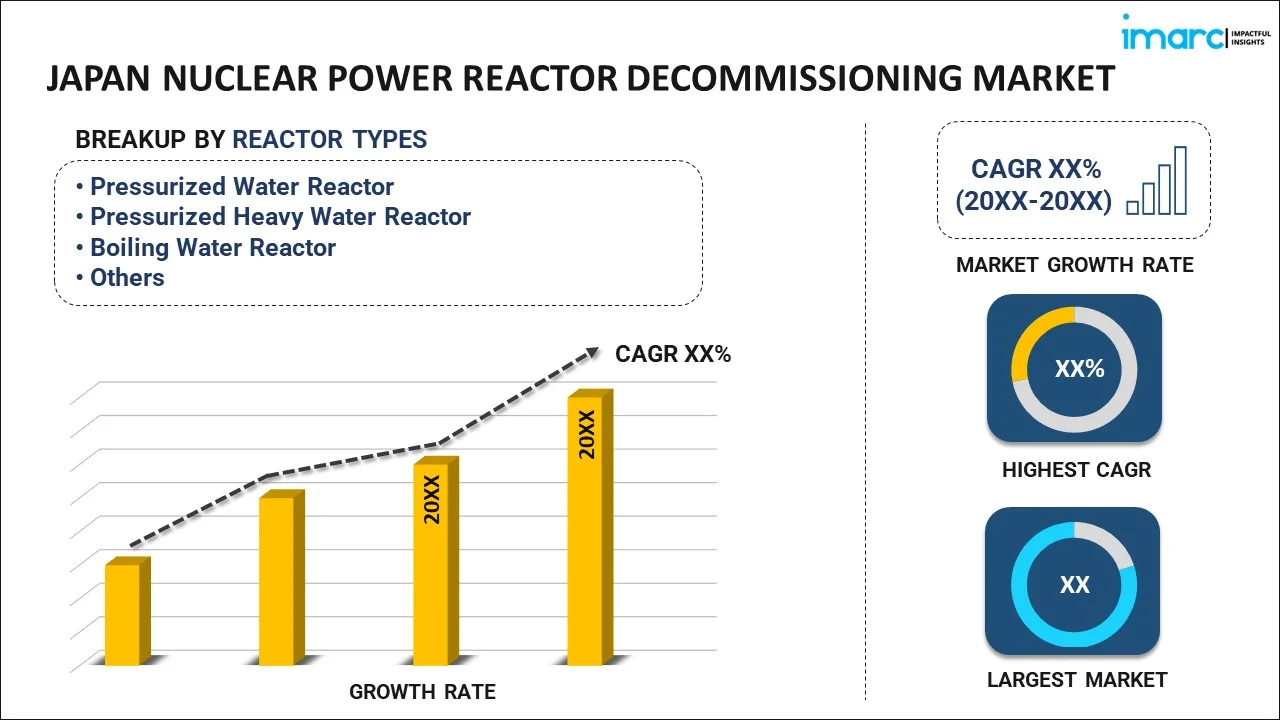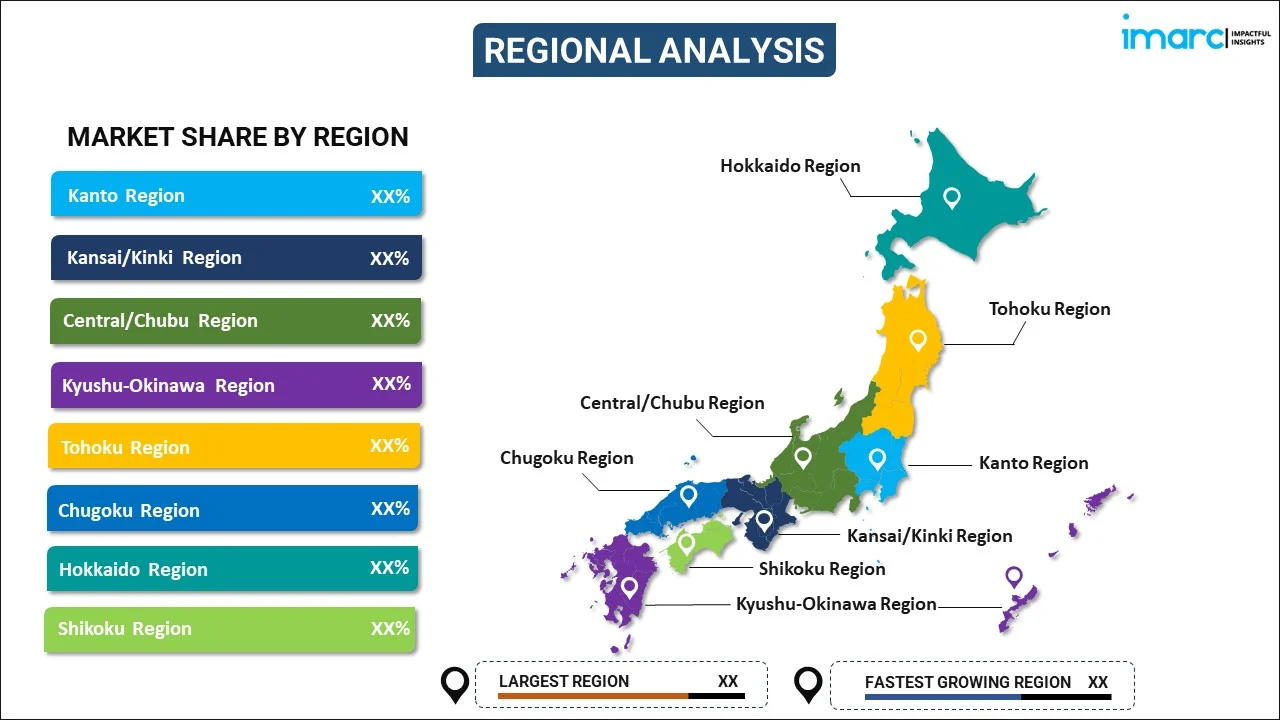
Japan Nuclear Power Reactor Decommissioning Market Report by Reactor Type (Pressurized Water Reactor, Pressurized Heavy Water Reactor, Boiling Water Reactor, High-temperature Gas-cooled Reactor, Liquid Metal Fast Breeder Reactor, and Others), Application (Commercial Power Reactor, Prototype Power Reactor, Research Reactor), Capacity (Below 100 MW, 100-1000 MW, Above 1000 MW), and Region 2025-2033
Market Overview:
Japan nuclear power reactor decommissioning market size reached USD 382.0 Million in 2024. Looking forward, IMARC Group expects the market to reach USD 531.0 Million by 2033, exhibiting a growth rate (CAGR) of 3.7% during 2025-2033. Numerous technological innovations, stringent safety standards, aging infrastructure, international collaboration, and a focus on public engagement represent some of the key factors driving the market.
|
Report Attribute
|
Key Statistics
|
|---|---|
|
Base Year
|
2024 |
|
Forecast Years
|
2025-2033
|
|
Historical Years
|
2019-2024
|
| Market Size in 2024 | USD 382.0 Million |
| Market Forecast in 2033 | USD 531.0 Million |
| Market Growth Rate (2025-2033) | 3.7% |
Nuclear power reactor decommissioning is a complex and multifaceted process that marks the end of a nuclear power plant's operational life. It entails the systematic and safe dismantling of the facility and its associated infrastructure, ensuring that radioactive materials are managed, contained, and ultimately disposed of in a manner that safeguards both human health and the environment. The decision to decommission a nuclear power reactor can arise from various factors, including the plant's age, regulatory requirements, or shifts in energy policy. Regardless of the reason, the decommissioning process is a highly regulated and meticulously planned endeavor that demands meticulous project management, rigorous safety measures, and adherence to stringent environmental standards. Nuclear power reactor decommissioning involves several key stages, including decontamination, dismantling, waste management, and site restoration. Each of these phases is executed with utmost care to minimize radiation exposure to workers, prevent the release of radioactive materials, and restore the site to a condition suitable for other uses or long-term monitoring.
Japan Nuclear Power Reactor Decommissioning Market Trends:
The nuclear power reactor decommissioning market in Japan has emerged as a significant and evolving sector, driven by a complex interplay of factors, including regulatory imperatives, technological advancements, and a commitment to managing the legacy of nuclear power. The nuclear power reactor decommissioning market in Japan has emerged as a significant and evolving sector, driven by a complex interplay of factors, including regulatory imperatives, technological advancements, and a commitment to managing the legacy of nuclear power. Besides this, stringent safety and regulatory compliance standards are driving the regional market. Moreover, Japan's nuclear reactors are aging and reaching the end of their operational lives. This aging infrastructure presents both challenges and opportunities for decommissioning service providers, as they work to safely dismantle and decontaminate these facilities. Public engagement and transparency have become central to Japan's nuclear decommissioning efforts. This, in turn, is projected to bolster the regional market in the coming years.
Japan Nuclear Power Reactor Decommissioning Market Segmentation:
IMARC Group provides an analysis of the key trends in each segment of the market, along with forecasts at the country level for 2025-2033. Our report has categorized the market based on reactor type, application, and capacity.
Reactor Type Insights:

- Pressurized Water Reactor
- Pressurized Heavy Water Reactor
- Boiling Water Reactor
- High-temperature Gas-cooled Reactor
- Liquid Metal Fast Breeder Reactor
- Others
The report has provided a detailed breakup and analysis of the market based on the reactor type. This includes pressurized water reactor, pressurized heavy water reactor, boiling water reactor, high-temperature gas-cooled reactor, liquid metal fast breeder reactor, and others.
Application Insights:
- Commercial Power Reactor
- Prototype Power Reactor
- Research Reactor
A detailed breakup and analysis of the market based on the application have also been provided in the report. This includes commercial power reactor, prototype power reactor, and research reactor.
Capacity Insights:
- Below 100 MW
- 100-1000 MW
- Above 1000 MW
The report has provided a detailed breakup and analysis of the market based on the capacity. This includes below 100 mw, 100-1000 mw, and above 1000 mw.
Regional Insights:

- Kanto Region
- Kansai/Kinki Region
- Central/ Chubu Region
- Kyushu-Okinawa Region
- Tohoku Region
- Chugoku Region
- Hokkaido Region
- Shikoku Region
The report has also provided a comprehensive analysis of all the major regional markets, which include Kanto Region, Kansai/Kinki Region, Central/ Chubu Region, Kyushu-Okinawa Region, Tohoku Region, Chugoku Region, Hokkaido Region, and Shikoku Region.
Competitive Landscape:
The market research report has also provided a comprehensive analysis of the competitive landscape in the market. Competitive analysis such as market structure, key player positioning, top winning strategies, competitive dashboard, and company evaluation quadrant has been covered in the report. Also, detailed profiles of all major companies have been provided.
Japan Nuclear Power Reactor Decommissioning Market Report Coverage:
| Report Features | Details |
|---|---|
| Base Year of the Analysis | 2024 |
| Historical Period | 2019-2024 |
| Forecast Period | 2025-2033 |
| Units | Million USD |
| Scope of the Report | Exploration of Historical and Forecast Trends, Industry Catalysts and Challenges, Segment-Wise Historical and Predictive Market Assessment:
|
| Reactor Types Covered | Pressurized Water Reactor, Pressurized Heavy Water Reactor, Boiling Water Reactor, High-temperature Gas-cooled Reactor, Liquid Metal Fast Breeder Reactor, Others |
| Applications Covered | Commercial Power Reactor, Prototype Power Reactor, Research Reactor |
| Capacities Covered | Below 100 MW, 100-1000 MW, Above 1000 MW |
| Regions Covered | Kanto Region, Kansai/Kinki Region, Central/ Chubu Region, Kyushu-Okinawa Region, Tohoku Region, Chugoku Region, Hokkaido Region, Shikoku Region |
| Customization Scope | 10% Free Customization |
| Post-Sale Analyst Support | 10-12 Weeks |
| Delivery Format | PDF and Excel through Email (We can also provide the editable version of the report in PPT/Word format on special request) |
Key Questions Answered in This Report:
- How has the Japan nuclear power reactor decommissioning market performed so far and how will it perform in the coming years?
- What has been the impact of COVID-19 on the Japan nuclear power reactor decommissioning market?
- What is the breakup of the Japan nuclear power reactor decommissioning market on the basis of reactor type?
- What is the breakup of the Japan nuclear power reactor decommissioning market on the basis of application?
- What is the breakup of the Japan nuclear power reactor decommissioning market on the basis of capacity?
- What are the various stages in the value chain of the Japan nuclear power reactor decommissioning market?
- What are the key driving factors and challenges in the Japan nuclear power reactor decommissioning?
- What is the structure of the Japan nuclear power reactor decommissioning market and who are the key players?
- What is the degree of competition in the Japan nuclear power reactor decommissioning market?
Key Benefits for Stakeholders:
- IMARC’s industry report offers a comprehensive quantitative analysis of various market segments, historical and current market trends, market forecasts, and dynamics of the Japan nuclear power reactor decommissioning market from 2019-2033.
- The research report provides the latest information on the market drivers, challenges, and opportunities in the Japan nuclear power reactor decommissioning market.
- Porter's five forces analysis assist stakeholders in assessing the impact of new entrants, competitive rivalry, supplier power, buyer power, and the threat of substitution. It helps stakeholders to analyze the level of competition within the Japan nuclear power reactor decommissioning industry and its attractiveness.
- Competitive landscape allows stakeholders to understand their competitive environment and provides an insight into the current positions of key players in the market.
Need more help?
- Speak to our experienced analysts for insights on the current market scenarios.
- Include additional segments and countries to customize the report as per your requirement.
- Gain an unparalleled competitive advantage in your domain by understanding how to utilize the report and positively impacting your operations and revenue.
- For further assistance, please connect with our analysts.
 Inquire Before Buying
Inquire Before Buying
 Speak to an Analyst
Speak to an Analyst
 Request Brochure
Request Brochure
 Request Customization
Request Customization




.webp)




.webp)












